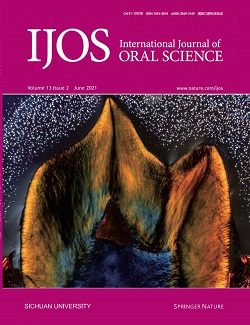PLAGL1-IGF2轴调控出生后髁突发育成骨。
IF 12.2
1区 医学
Q1 DENTISTRY, ORAL SURGERY & MEDICINE
引用次数: 0
摘要
下颌髁是颅面骨发育的关键生长中心,特别是在出生后阶段。出生后髁骨形成需要生长因子信号级联和分级基因调控网络的精确时空协调。Plagl1编码锌指转录因子,是一种父系表达基因。我们证明PLAGL1在小鼠髁的颅神经嵴细胞(CNCC)衍生谱系细胞中高度表达。使用cncc衍生的谱系特异性Plagl1敲除小鼠模型,我们评估了Plagl1在出生后小鼠髁发育中的功能。我们的研究结果表明,PLAGL1对成骨细胞的分化有重要作用,其缺乏会损害成骨谱系的分化,从而破坏下颌髁的发育。在机制上,胰岛素样生长因子2 (IGF2)与igf结合蛋白(igfbp)的复合物已被确定为PLAGL1在出生后髁状突形态发生过程中负责成骨调节的主要效应物。Plagl1缺乏显著下调IGF2/IGFBP通路,导致糖代谢紊乱、细胞外基质组织缺陷和骨化受损。外源性IGF2治疗可挽救由Plagl1缺乏引起的成骨细胞分化受损。综上所述,PLAGL1-IGF2轴是下颌髁发育过程中骨生成的关键调节因子。本文章由计算机程序翻译,如有差异,请以英文原文为准。
PLAGL1-IGF2 axis regulates osteogenesis of postnatal condyle development.
The mandibular condyle is a critical growth center in craniofacial bone development, especially during postnatal stages. Postnatal condyle osteogenesis requires precise spatiotemporal coordination of growth factor signaling cascades and hierarchical gene regulatory networks. Plagl1, which encodes a zinc finger transcription factor, is a paternally expressed gene. We demonstrate that PLAGL1 is highly expressed in cranial neural crest cell (CNCC)-derived lineage cells in mouse condyles. Using the CNCC-derived lineage-specific Plagl1 knockout mouse model, we evaluate the function of PLAGL1 during postnatal mouse condyle development. Our findings show that PLAGL1 contributes significantly to osteoblast differentiation, and its deficiency impairs osteogenic lineage differentiation, which consequently disrupts mandibular condyle development. Mechanistically, insulin-like growth factor 2 (IGF2) in complex with IGF-binding proteins (IGFBPs) has been identified as the principal PLAGL1 effector responsible for osteogenic regulation during postnatal condyle morphogenesis. Plagl1 deficiency significantly downregulates the IGF2/IGFBP pathway, leading to disordered glucose metabolism, defective extracellular matrix organization, and impaired ossification. Exogenous IGF2 treatment rescues impaired osteoblast differentiation caused by Plagl1 deficiency. In conclusion, the PLAGL1-IGF2 axis is a critical regulator of osteogenesis during mandibular condyle development.
求助全文
通过发布文献求助,成功后即可免费获取论文全文。
去求助
来源期刊

International Journal of Oral Science
DENTISTRY, ORAL SURGERY & MEDICINE-
CiteScore
31.80
自引率
1.30%
发文量
53
审稿时长
>12 weeks
期刊介绍:
The International Journal of Oral Science covers various aspects of oral science and interdisciplinary fields, encompassing basic, applied, and clinical research. Topics include, but are not limited to:
Oral microbiology
Oral and maxillofacial oncology
Cariology
Oral inflammation and infection
Dental stem cells and regenerative medicine
Craniofacial surgery
Dental material
Oral biomechanics
Oral, dental, and maxillofacial genetic and developmental diseases
Craniofacial bone research
Craniofacial-related biomaterials
Temporomandibular joint disorder and osteoarthritis
The journal publishes peer-reviewed Articles presenting new research results and Review Articles offering concise summaries of specific areas in oral science.
 求助内容:
求助内容: 应助结果提醒方式:
应助结果提醒方式:


